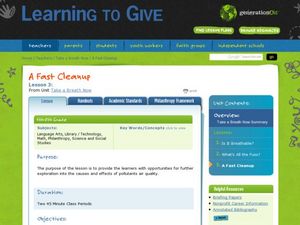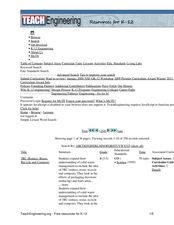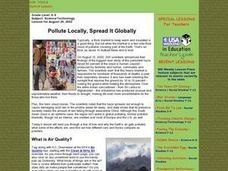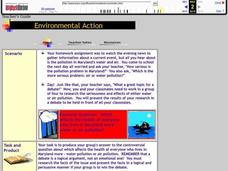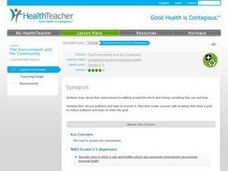Curated OER
Air Pollution and Asthma (11th Grade)
What is the air quality index? Start by discussing pollution and air quality with your budding environmentalists. A list of instructional activities are provided here from inviting a guest speaker into your classroom to discussing...
Baylor College
There's Something in the Air
Clever! In order to compare indoor and outdoor dispersal rates for the movement of gases and particles through air, collaborators will participate in a classroom experiment. Set up a circular grid and set students on lines that are...
Baylor College
Healthy Homes
Meant to follow a instructional activity about how concentrated air particles can be inside of a building, this resource gets individuals to assess the possible air pollutants in their own homes. They take home a worksheet and circle...
Curated OER
The O Zone-Code Read Alert
What are the effects of an air quality alert? Expert groups receive one component of air quality information resources to study. Pupils then jigsaw into new groups and share their knowledge. Finally, they draft a statement of what they...
Baylor College
Dust Catchers
In class, your emerging environmentalists construct dust catchers. They take them home for a week or two, and then bring them back into class to examine under a magnifier. From this activity, they learn what makes up dust and that...
Curated OER
What's Air Got to Do with It?
Young scholars use M&M's to create a pie graph that expresses their understanding of the composition of air. They watch and conduct several simple experiments to develop an understanding of the properties of air (it has mass, it...
Curated OER
A Fast Cleanup
Learners discover the causes and effects of air pollution. In this stewardship lesson, students explore the Air Quality Index, research pollutants, and present their findings.
Texas State Energy Conservation Office
Investigation: Blowing in the Wind
Using a simulated air sample, environmental or earth science pupils examine the components. You will need to prepare the faux air by using a hole punch and various colors of construction paper. Each color will represent a different...
Curated OER
What Color is Your Air Today?
Students investigate air quality. They analyze Air Quality Index data tables, interpret the graphs, complete a worksheet, and discuss trends in air quality.
Curated OER
How Clean is Your Air?
In this ecology learning exercise, students study the Air Quality Index in their area and complete 8 short answer questions related to this topic.
Curated OER
Air Pollution: A Local and Global Problem
Students investigate the problem of air pollution in a given location and research possible solutions using a variety of tools (laboratory technology, Internet resources, multimedia technology, etc.).
Curated OER
Got Dirty Air?
Students study air pollution and its effect on air quality. In this environmental science and engineering lesson, students watch a demonstration of incomplete combustion as it contributes to air pollution, study the importance of air,...
Baylor College
Fungus Among Us
In order to learn that mold spores can be found in the air, observers grow bread mold and make observations for a few days. Afterward, they participate in a class discussion to arrive at the knowledge that bread spores are present in the...
Curated OER
Pollute Locally, Spread It Globally
Students examine the rate of pollution throughout the world through an interactive program. They define air quality and the air quality index. They examine fuel economy and its impact on the Earth and renewable and nonrenewable resources.
Curated OER
Air Quality Trivia Time
Students identify and analyze what the Air Quality Index (AQI) is and how it works. They review ways that "unhealthy" or "hazardous" days could be prevented and draw and color something that they can do to help reduce air pollution....
Curated OER
Air Pollution Allowance Trading
Students study pollution abatement measures based on free market trading of pollution allowances. They make a series of decisions in order to comply with environmental regulations, as well as determine the price of a pollution allowance,...
Curated OER
Environmental Action
Middle schoolers debate one another. In this pollution lesson, pupils work in teams to debate which is more serious, air or water pollution. They research their topic to come up with valid points to justify their side of the debate.
Curated OER
Recycling: Causes of Pollution
Students read The Lorax by Dr. Seuss while focusing on similarities in their world and that of the Lorax by completing a worksheet. They examine the effects of pollution or garbage on the environment.
Curated OER
Heavy Breathing
Students investigate asthma and air quality, and then map or graph the incidence of asthma by county and air quality information by county in the state of Maryland. They attempt to see any correlations and note any limitations of the data.
Curated OER
The Environment and the Community
Students consider ways to reduce air, water, noise, and litter pollution in their community. In this environment lesson plan, students discuss and set goals for reducing pollution and keep a log of the changes they make individually to...
Curated OER
Weather Watchers
Students study basic meteorology concepts. They build a simple barometer to measure air pressure. They explore the concepts of relative humidity, air convection currents and temperature inversions and to discover their connection to...
Curated OER
The Environment and the Community
Students observe their environment and come up with ways to protect it. In this environment lesson plan, students discuss pollution and ways to prevent it. Then they create a poster with drawings that show a goal to reduce pollution and...
Curated OER
Compare Your Air
Students will compare the data for different locations that they select and investigate trends over the course of a number of years. This will give the students an opportunity to apply statistical measures (mean, median,mode) to data...
Curated OER
Social Studies: Canadian City Comparison
Students research Canadian population distribution while comparing and contrasting the quality of life in two cities. They discuss issues and problems that cities and rural towns face. Students apply various methods, such as graphs and...








